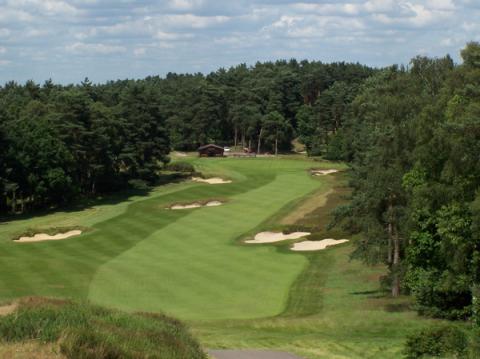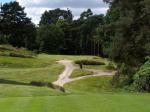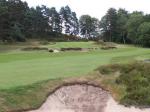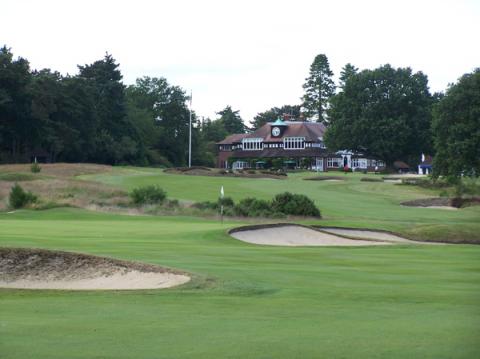
Virtually every hole at Sunningdale could be the "signature" hole at most courses, but the par 4 10th is probably the most visually stunning of all.
The Willie Park Jr. designed Sunningdale Old Course, opened in 1901 and updated by Henry Colt in the ‘20s, should be on every seriously golfer's list to play whilst in England. Although we were hosted there by an acquaintance, the club will accept some outside play Mondays through Thursdays. Green fees range as high as $370 US but the experience is well worth the price tag. The extra little touches of a great club are there as well: The best cup of coffee I had in three weeks in the British Isles was in the Sunningdale clubhouse lounge, overlooking the practice green. And it was complimentary.
The par 70 Sunningdale course reminded me at times of Pine Valley, the best golf course I have ever played, as well as Shinnecock Hills. Both those classic American courses
Fairway and green turf conditions were near perfect, with firm and fast putting surfaces and lush fairways. Sunningdale is every bit a player's course, and those looking for a relaxing resort type trip around are advised to stay away. One American in the foursome behind us seemed exhausted as he trudged up the 17th hole. I sympathized mightily. I played to double my handicap at Sunningdale because I did not hit the ball straight off the tees. My son Tim had a similar problem off the tees and scored his highest round of the week, a 78. Yet we enjoyed the experience and recognition that we were on one of the finest routings in the world. Next time, we hope to add a round at the adjacent Henry Colt designed New Course (circa 1923), considered by some members the equal of the Old Course.
in the foursome behind us seemed exhausted as he trudged up the 17th hole. I sympathized mightily. I played to double my handicap at Sunningdale because I did not hit the ball straight off the tees. My son Tim had a similar problem off the tees and scored his highest round of the week, a 78. Yet we enjoyed the experience and recognition that we were on one of the finest routings in the world. Next time, we hope to add a round at the adjacent Henry Colt designed New Course (circa 1923), considered by some members the equal of the Old Course.
Sunningdale presents virtually every hazard a classic course can muster, in addition to the heather. A huge grassy knoll covers the view of the entire right side of #1, a short par 5 at just 492 yards. A large bush and bunker protect the left side nearer the green. The effect is of a narrow entranceway, which toughens up the reachable five-shot hole (reachable, that is, for some). The course mixes in a few short par 4s, such as #3, at just 278 yards. But these are not grip and rip holes, and the smart player will substitute brains for brawn on those holes whose distances are embellished with trouble. At #3, for example, two nasty spectacle bunkers guard the right side landing area, and the fairway beyond tilts right toward the heather. The green is one of the more undulating on the course.
A few creeks frame some of the holes at Sunningdale but water is not a big factor on the course except at the 400-yard par 4 5th hole, with a perfectly round pond that stretches from 74 yards from the green to 33 yards, making any thinly hit approach a sure bogey or worse. There is no safe entryway to the green as the left side is fully guarded by sand bunkers, as is the front right side just a few yards beyond the pond. If you play too long, heather and trees await beyond the green.
stretches from 74 yards from the green to 33 yards, making any thinly hit approach a sure bogey or worse. There is no safe entryway to the green as the left side is fully guarded by sand bunkers, as is the front right side just a few yards beyond the pond. If you play too long, heather and trees await beyond the green.
I found the greens quite difficult to read. A few times I aimed my putts a ball or two to one side of the cup and they rolled an equivalent distance the other way. (My eye doctor tells me I need some corrective surgery on my eyes in the fall, so perhaps the greens were not that tough.) But they were easily the fastest surfaces of any we played over 10 days, not exactly lightning but they will be for the Women's Open in a few weeks.
Sunningdale permitted my son Tim to play from the back tees (6,700 yards), the only course of our vacation that didn't force him to play the regular tees. The Old Course at St. Andrews and the other links courses we played in Scotland reserve the "medal" tees for professionals and official club tournaments. Those medal tees, by the way, are barely longer than 6,000 yards but, okay, it is their courses and they make the rules.
But Sunningdale (back tees 6,600 yards), according to our gracious host for the day, Helena Felix, is a "members club"; members and their guests have mostly unimpeded access to the premises. (On the day we played, Sunningdale's Old Course was available for four-ball play only; twosomes were required to play the New Course.) From the free and terrific coffee in the stunning old clubhouse to the friendly greetings in the pro shop and locker room, Sunningdale presents itself pretty much like any well-run, casual private club. However, there is nothing "casual" about the wonderfully challenging Sunningdale, the toughest test of the eight outstanding courses we played in the United Kingdom.
Tim and I will publish our overall rankings of the eight here in the next few days.

Beyond the 17th green lie the 18th fairway and Sunningdale's stunning and accommodating clubhouse.
Sunningdale Golf Club, Old Course (Par 70)
Yardages (rating and slope not available)
Back tees/6,627; white/6,308; orange/6,063; red/5,825(par 74)



